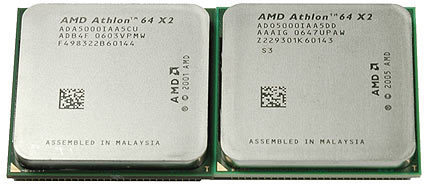Can AMD'S 65 nm Core Fight Back?
100 MHz Speed Increments Are Back
The 90 nm Windsor versus the 65 nm Brisbane: the differences in performance are negligible, but the new processor helps to save energy.
With the current AM2 processor lineup, AMD said farewell to the current clock speeds model and re-introduced odd clock speeds (2.1 GHz, 2.3 GHz, 2.5 GHz). One reason might have been differentiation between old and new processor versions: although carrying the same model numbers, all 90 nm Athlon 64 X2 processors run at even clock speeds, while three of the four 65 nm Brisbane products run at these odd clock speeds.
Memory Speeds Can Vary
Apart from that differentiation, we cannot see the advantage of going this way, as it reintroduces odd multipliers (10.5, 11.5, 12.5), in turn leading to relatively low memory clock speeds. Every Athlon 64 X2 processor has to operate its DDR2 memory within the limits of DDR2-800 (400 MHz). To do so, the BIOS will typically run the highest possible memory divider, so the RAM runs within its specification, as shown in the following table:
| Athlon 64 X2 | Core Clock | Memory Divider | Memory Clock |
|---|---|---|---|
| 4000+ | 2100 MHz | 6 | 350 MHz(DDR2-700) |
| 4400+ | 2300 MHz | 6 | 383 MHz(DDR2-746) |
| 4800+ | 2500 MHz | 7 | 357 MHz(DDR2-714) |
| 5000+ | 2600 MHz | 7 | 371 MHz(DDR2-742) |
The processor can only use integers to derive the memory clock speed, which means that it will divide the processor clock speed by the memory divider. As you can see in the table, none of the new processors runs the memory at the full 400 MHz speed (DDR2-800). Although a few megahertz in memory clock speed will not impact your overall performance very much, DDR2-700 instead of DDR2-800 certainly does make a difference in synthetic benchmarks. At the same time, the reduced memory clock speed also has an impact on system power consumption, which means that an Athlon 64 X2 4000+ Brisbane is not a good choice from a performance point of view, but attractive from an energy-efficiency standpoint.
Power Consumption: 65 W TDP
Generally speaking, all new 65 nm Athlon 64 X2 processors require less energy. Our test results show that the energy savings between a system with a Windsor processor and a Brisbane-equipped machine at 2.6 GHz is 2% in idle mode with Cool'n'Quiet enabled (Brisbane offers the Enhanced Halt Mode C1E), 5% in idle without Cool'n'Quiet, and as much as 11% under full load. The last number especially makes clear the huge difference that the new processor makes in energy consumption!
Get Tom's Hardware's best news and in-depth reviews, straight to your inbox.
Current page: 100 MHz Speed Increments Are Back
Prev Page AMD Outputs 65 nm Silicon Next Page The 65 nm Brisbane Has Longer L2 Cache Latency
Patrick Schmid was the editor-in-chief for Tom's Hardware from 2005 to 2006. He wrote numerous articles on a wide range of hardware topics, including storage, CPUs, and system builds.

